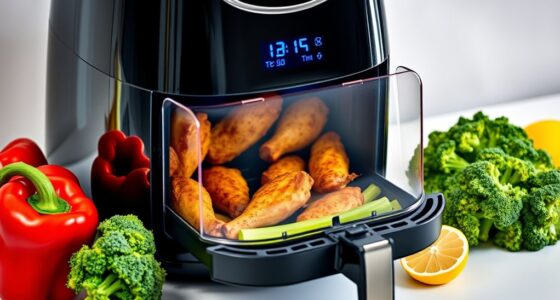To childproof your kitchen, start by securing cabinets and drawers with locks to keep hazards out of reach. Cover electrical outlets and hide wires to prevent shocks. Store sharp and hot items safely away from children, and install stove and oven guards. Keep dangerous chemicals high or locked up, and clear the floor of toys and spills to prevent trips. To learn more about creating a safe kitchen, keep exploring these essential safety tips.
Key Takeaways
- Secure all hazards by installing childproof locks on cabinets and storing chemicals out of reach.
- Cover electrical outlets and keep cords tucked away to prevent shocks and tripping.
- Store hot, sharp, and heavy items on high shelves or in locked cabinets.
- Maintain a clutter-free, slip-resistant floor to prevent falls and injuries.
- Keep small objects and choking hazards out of children’s reach and supervise meal times.
Securing Cabinets and Drawers
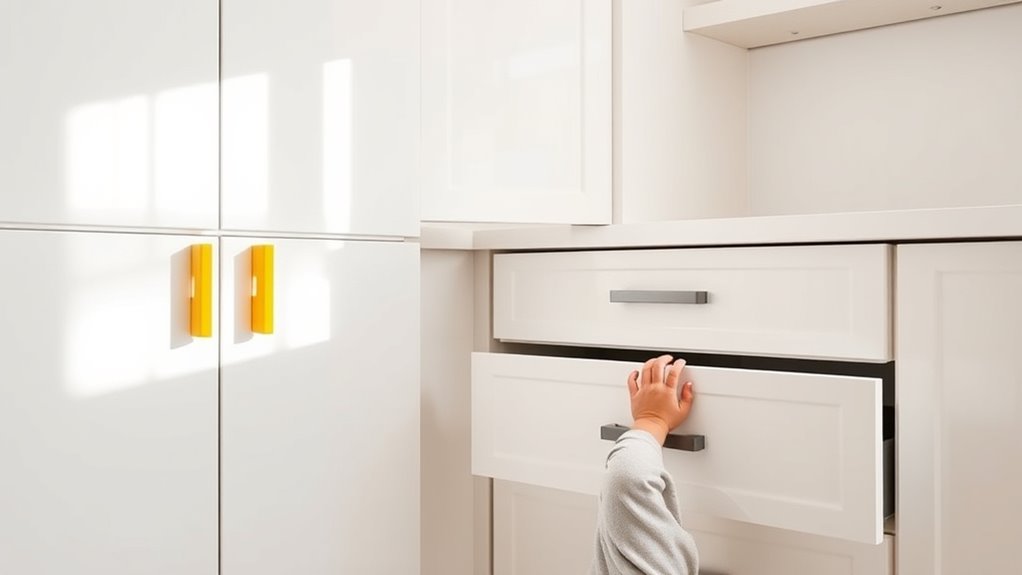
To prevent curious little hands from accessing dangerous items, securing cabinets and drawers is essential. Installing cabinet locks keeps sharp knives, cleaning supplies, and other hazards out of reach. Choose childproof cabinet locks that are easy for adults to open but difficult for children. Drawer latches are equally important, preventing young explorers from pulling out drawers filled with utensils or small objects. Opt for latch styles that don’t damage furniture and are simple to operate for adults. Regularly check that locks and latches are secure and functioning properly. This simple step creates a safer environment, reducing the risk of accidents. Incorporating water safety awareness into your childproofing plan can further protect your little ones around pools and other water sources. With the right cabinet locks and drawer latches, you take an important step toward childproofing your kitchen effectively.
Covering Electrical Outlets and Wires

Since electrical outlets and wires pose significant safety hazards in the kitchen, covering them is a vital step in childproofing. Outlet covers prevent curious kids from inserting objects or fingers into outlets, reducing the risk of electrical shock. Use plastic outlet covers or tamper-resistant outlets for added electrical safety. Wires should be tucked away or secured to avoid tripping or pulling. Consider using cord organizers or covers to keep wires out of reach. Here’s a quick comparison:
| Outlet Covers | Wire Management |
|---|---|
| Prevent accidental shocks | Keep cords out of reach |
| Easy to install | Use clips or ties |
| Transparent for visibility | Tidy workspace |
| Tamper-resistant options | Reduce tripping hazards |
| Affordable safety measure | Simplifies cleaning |
Covering outlets and wires keeps your kitchen safe and reduces electrical hazards. Proper industry knowledge can help you choose the best safety products for your home.
Managing Sharp and Hot Items

You should store sharp tools like knives and scissors safely out of your child’s reach to prevent accidents. Always use childproof covers on hot surfaces and appliances to avoid burns. Keep hot items, such as pots and pans, on the back burners or out of your child’s sight and reach.
Store Sharp Tools Safely
Storing sharp and hot tools safely is essential to prevent accidents in the kitchen. To guarantee sharp knife safety, always store knives in a designated knife block or on a magnetic strip out of children’s reach. Avoid leaving cutting tools loose in drawers, as this increases the risk of cuts. Use protective sheaths or blade guards when storing knives in drawers or cabinets. Keep hot tools, such as spatulas and tongs, in high or locked cabinets to prevent children from grabbing them. Regularly check storage areas for any hazards or misplaced tools. Incorporating cultural safety practices, such as teaching children about kitchen hazards, can further enhance safety. By organizing your kitchen with safety in mind, you reduce the chances of children accessing dangerous items and create a safer environment for everyone.
Use Childproof Hot Covers
Using childproof hot covers on pots, pans, and other hot appliances provides an extra layer of protection against burns and scalds. These covers are designed to insulate handles and knobs, making it harder for curious little hands to grab hot surfaces. By preventing burns, childproof hot covers help keep your child safe while cooking or baking. They are easy to install and remove, fitting most standard cookware and appliances. Regularly check the covers for wear and tear to guarantee ongoing effectiveness. Remember, while hot covers substantially reduce risks, they should be part of an all-encompassing safety strategy. Always supervise children in the kitchen and teach them about the dangers of hot items. Combining these precautions creates a safer environment for everyone. Incorporating safety checklists can help ensure all potential hazards are addressed.
Keep Hot Items Out of Reach
To prevent accidents, keep hot and sharp items out of your child’s reach at all times. Proper hot item placement is essential for stove safety. Always turn pot handles inward so little hands can’t pull them down or bump into them. Use back burners whenever possible, especially when cooking with kids nearby. Keep sharp knives and utensils stored in secure drawers or high shelves, out of your child’s sight and reach. Never leave hot items unattended on the stove, even for a moment. By maintaining vigilant hot item placement and practicing stove safety, you reduce the risk of burns or cuts. Remember, a safe kitchen is a proactive kitchen—think ahead and organize to keep your child protected from potential hazards. Incorporating sound safety practices can further enhance your kitchen safety measures and ensure a secure environment for your little ones.
Installing Safe Stoves and Oven Guards
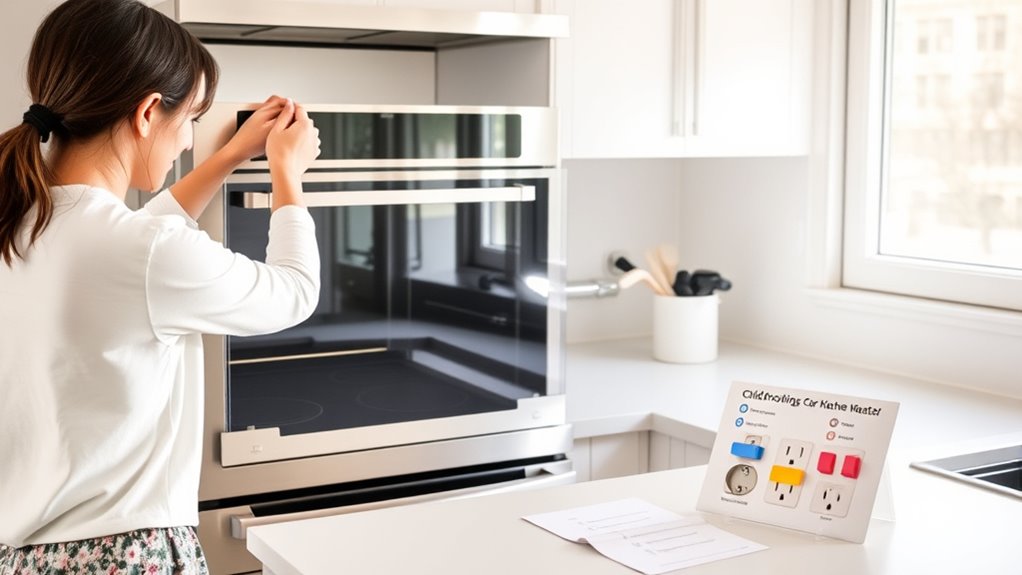
You can make your stove safer by installing safety barriers that keep curious hands away from burners. Oven guards also help prevent burns by shielding your child from hot surfaces. These simple additions give you peace of mind while still allowing your kitchen to be functional. Additionally, ensuring proper installation and venting can prevent dangerous gas buildup and reduce fire hazards.
Childproofing Stoves: Safety Barriers
Installing safety barriers on stoves and ovens is a crucial step in childproofing your kitchen, as it prevents curious little hands from reaching hot surfaces or opening dangerous compartments. One effective way is to use childproof stove knobs that require an extra push or twist to turn, reducing accidental ignition. Additionally, stove safety barriers like custom covers or guards can block access to burners and dials, keeping your child safe. These barriers are easy to install and remove, giving you flexibility when cooking or cleaning. By securing the stove with these safety measures, you minimize risks of burns or fires caused by unsupervised children. Remember, combining childproof stove knobs with sturdy stove safety barriers creates a safer environment for your little explorer. According to beauty store hours, many stores offer online shopping with extended hours, making it easier to purchase safety products at your convenience.
Oven Guards: Prevent Burns
Since hot ovens pose a significant burn risk, adding oven guards can be a vital part of childproofing your kitchen. These guards help guarantee oven safety by preventing children from accidentally touching hot surfaces or opening the door during cooking. Installing oven locks or barriers keeps curious little hands away from dangerous areas, reducing the chance of burns. Make certain the guards are sturdy and easy for adults to operate but difficult for children to bypass. Additionally, always keep oven handles turned inward and avoid placing items on the edge of the stove. Properly installed oven guards are a simple yet effective way to promote burn prevention and create a safer environment for your family. Using child safety products can further enhance your kitchen’s safety features.
Storing Dangerous Substances Out of Reach
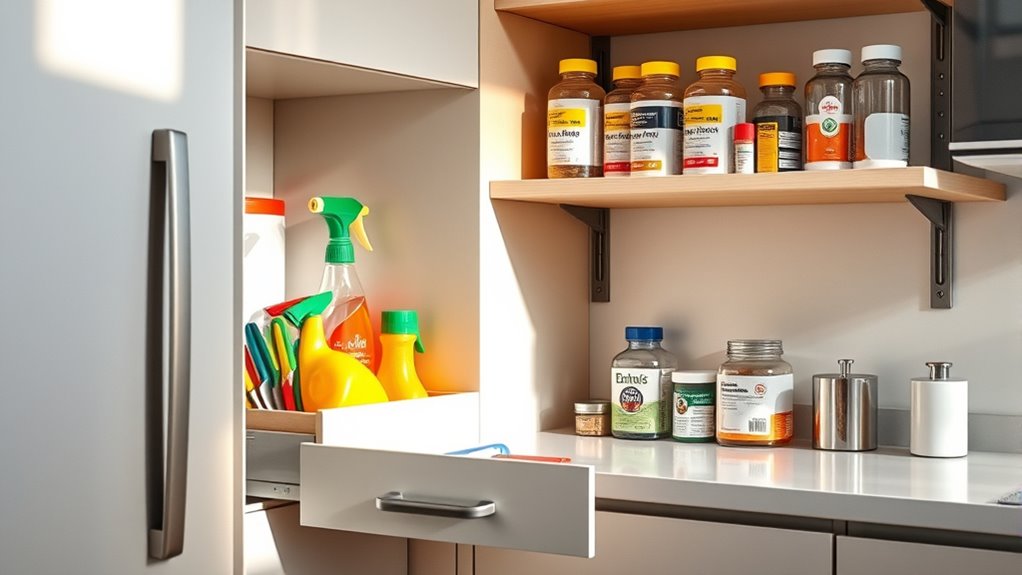
Have you ever considered how easily children can access dangerous substances in the kitchen? Storing chemical hazards out of reach is essential for poison prevention. Keep cleaning supplies, pesticides, and other toxic products on high shelves or in locked cabinets. Use childproof locks on cabinet doors and drawers containing these items. Never leave chemicals unattended, even for a moment. Be mindful of items like vitamins or medications that look similar to food; store them securely too. By establishing a designated, out-of-reach storage area, you minimize the risk of accidental ingestion. Remember, children are naturally curious, so proactive storage is your best defense against dangerous substances. Incorporating safe storage practices can further reduce the likelihood of accidents and ensure your child’s safety. Prioritizing safe storage practices helps protect your child from potential harm caused by chemical hazards.
Creating a Safe Floor Space
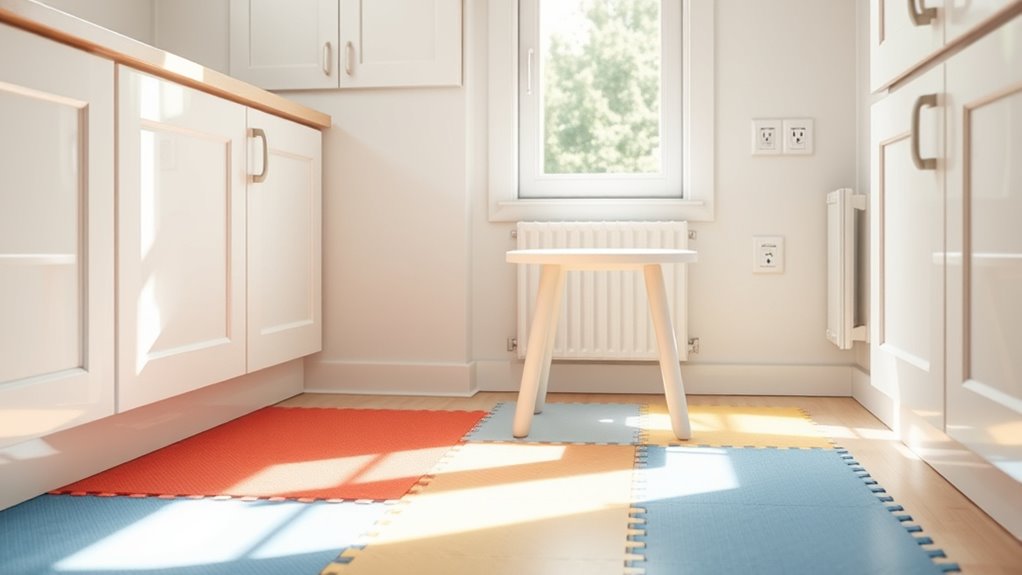
A cluttered or uneven floor can quickly turn into a hazard for curious children exploring the kitchen. To create a safe floor space, prioritize non-slip flooring that reduces the risk of slips and falls. Consider installing non-slip tiles, rubber mats, or textured vinyl flooring, especially in high-traffic areas. Soft surface options, like foam mats or padded rugs, offer extra cushioning and can protect your child from injuries if they fall. Keep the floor clear of toys, spills, and debris to prevent tripping hazards. Regularly inspect for loose rugs or tiles that could cause a fall. Using appropriate headsets can also help minimize noise distractions and prevent accidents around the kitchen area. By maintaining a clean, stable, and slip-resistant surface, you’ll considerably minimize accidents and create a safer environment for your little explorer.
Keeping Small Objects and Choking Hazards Away
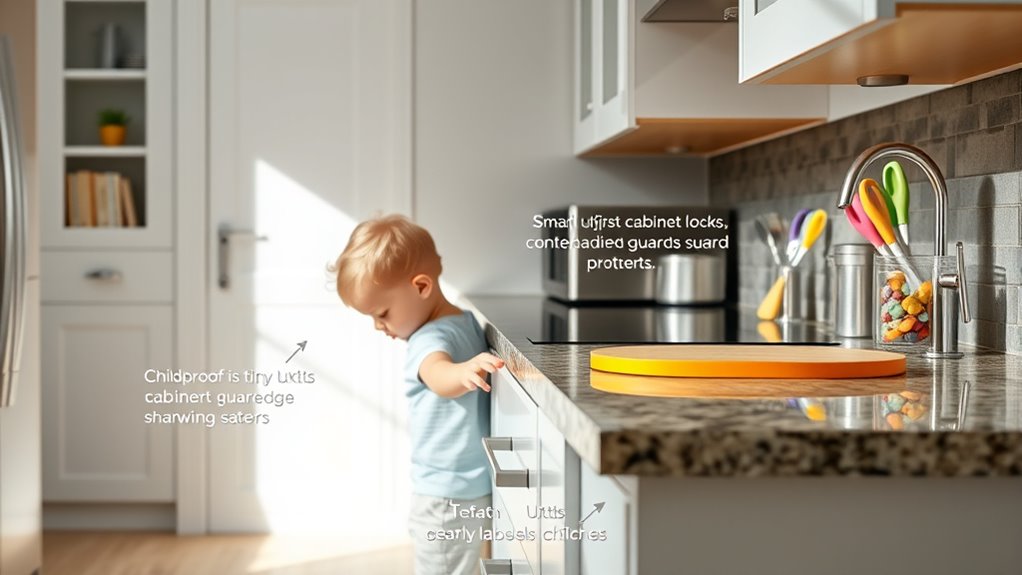
To prevent choking hazards in your kitchen, it’s essential to keep small objects out of your child’s reach. Small object hazards, like coins, buttons, utensils, or food items, can pose serious choking risks. Regularly scan your countertops, drawers, and shelves to remove or secure items that could be swallowed. Use childproof containers or storage bins for tiny objects, and always supervise your child during meal prep and snack time. Keep cleaning supplies and other small, hazardous items stored in high cabinets or locked drawers. Educate yourself on choking prevention by recognizing which objects are dangerous and removing them promptly. Making these small adjustments markedly reduces the risk of choking, creating a safer environment for your little one to explore. Additionally, understanding child safety tips can help you better protect your household from common hazards.
Frequently Asked Questions
How Can I Childproof My Kitchen on a Tight Budget?
To childproof your kitchen on a tight budget, focus on budget-friendly tips like using cabinet locks made from inexpensive materials or DIY safety hacks, such as securing sharp objects and cleaning supplies out of reach. You can also place everyday items in higher cabinets or containers. Regularly supervise your child and teach safety rules. These simple, cost-effective measures help keep your little one safe without breaking the bank.
Are There Specific Childproofing Products for Different Age Groups?
Yes, there are specific childproofing products for different age groups. You should select age-appropriate products that match your child’s developmental stages, like corner protectors for toddlers who are learning to walk and stove knob covers for curious infants. As your child grows, switch to more advanced safety devices. This guarantees you’re providing the right level of protection without unnecessary hazards, helping your child stay safe in the kitchen at every stage.
How Often Should I Check and Update Safety Measures?
You should check and update safety measures monthly because, according to safety data, kitchen accidents peak within the first year of a child’s life. Regularly inspect for fire hazards and guarantee appliance safety, as children can quickly access dangerous items. Keep an eye on new hazards as your child grows, and adjust safety measures accordingly to prevent accidents. Staying vigilant helps create a safer environment for your little one.
What Are the Most Common Kitchen Injuries Among Children?
You should be aware that the most common kitchen injuries among children involve sharp knives and hot surfaces. Kids can accidentally cut themselves or burn their hands if they reach for knives or touch hot stoves and pots. To prevent these injuries, keep knives out of reach and use stove knob covers. Always supervise your children closely in the kitchen, and teach them about potential hazards to keep them safe.
Can I Childproof a Rental Kitchen Effectively?
Yes, you can effectively childproof a rental kitchen despite limitations. You’ll need to focus on temporary safety solutions like outlet covers, stove knob covers, and cabinet locks that don’t cause damage. These options are easy to install and remove, making them perfect for rental kitchens. By taking these steps, you guarantee your child’s safety without risking your security deposit, making your rental kitchen safer and more child-friendly.
Conclusion
By childproofing your kitchen, you create a fortress where your little one can explore safely, like a castle with hidden traps only an adult can see. Keep cabinets locked, outlets covered, and dangerous items out of reach, turning your kitchen into a safe haven instead of a minefield. With these simple steps, you’ll foster a space where curiosity can flourish without fear, giving you peace of mind as your child’s world grows richer and more adventurous.



